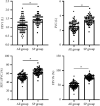Changes in Thrombelastography in Patients with Acute Exacerbation of Chronic Obstructive Pulmonary Disease and the Relationship with Lung Function
- PMID: 36406934
- PMCID: PMC9671723
- DOI: 10.1155/2022/4313394
Changes in Thrombelastography in Patients with Acute Exacerbation of Chronic Obstructive Pulmonary Disease and the Relationship with Lung Function
Retraction in
-
Retracted: Changes in Thrombelastography in Patients with Acute Exacerbation of Chronic Obstructive Pulmonary Disease and the Relationship with Lung Function.Emerg Med Int. 2024 Jan 24;2024:9827346. doi: 10.1155/2024/9827346. eCollection 2024. Emerg Med Int. 2024. PMID: 38298961 Free PMC article.
Abstract
Purpose: To analyze the changes in thrombelastography (TEG) in patients with acute exacerbation of chronic obstructive pulmonary disease (AECOPD) and the relationship with indicators related to lung function.
Methods: 100 patients with AECOPD admitted to our hospital from May 2021 to May 2022 were selected as the AE group, and another 80 patients with a stable phase of COPD in the same period were selected as the SP group. Fresh blood specimens were collected from both groups, and TEG-related indicators (R value, K value, α-angle, MA value) were measured using the TEG technique, and lung function-related indicators (FEV1, FVC, FEV1/FVC, FEV1%) were measured using a lung function meter, and the correlation between TEG-related indicators and lung function-related indicators was analyzed.
Results: Patients in the AE group had lower R and K values and higher α-angle and MA values than those in the SP group, all with statistically significant differences (P < 0.05). Patients in the AE group had lower FEV1, FVC, FEV1/FVC, and FEV1% levels than those in the SP group, all with statistically significant differences (P < 0.05). Correlation analysis showed that the R value in TEG of AECOPD patients was positively correlated with pulmonary function-related indicators (FEV1, FVC, FEV1/FVC, FEV1%) (r = 0.565, 0.529, 0.447, 0.527, all P < 0.001); K value was positively correlated with pulmonary function-related indicators (FEV1, FVC, FEV1/FVC, FEV1%) (r = 0.512, 0.567, 0.459, 0.439, all P < 0.001); α-angle was inversely correlated with pulmonary function-related indicators (FEV1, FVC, FEV1/FVC, FEV1%) (r = -0.498, -0.372, -0.408, -0.424, all P < 0.001); MA value was inversely correlated with lung function-related indicators (FEV1, FVC, FEV1/FVC, FEV1%) (r = -0.459, -0.429, -0.394, -0.403, all P < 0.001).
Conclusion: There is a correlation between TEG-related indicators and lung function-related indicators in AECOPD patients, both of which can guide the diagnosis and treatment process of the disease and are worthy of clinical promotion. The clinical registration number is EA2021086.
Copyright © 2022 Yan Zhou et al.
Conflict of interest statement
The authors declare that they have no conflicts of interest.
Figures






Similar articles
-
[Expression of serous fibroblast growth factor 7 and related inflammatory factors in patients with acute exacerbation of chronic obstructive pulmonary disease].Zhonghua Wei Zhong Bing Ji Jiu Yi Xue. 2021 Apr;33(4):421-426. doi: 10.3760/cma.j.cn121430-20201231-00786. Zhonghua Wei Zhong Bing Ji Jiu Yi Xue. 2021. PMID: 34053484 Chinese.
-
[Application value of thromboelastography in patients with multiple trauma in emergency department].Zhonghua Wei Zhong Bing Ji Jiu Yi Xue. 2019 May;31(5):623-628. doi: 10.3760/cma.j.issn.2095-4352.2019.05.020. Zhonghua Wei Zhong Bing Ji Jiu Yi Xue. 2019. PMID: 31198152 Chinese.
-
Application Value of Blood Heparin-Binding Protein in the Diagnosis of Acute Exacerbation of Chronic Obstructive Pulmonary Disease.Contrast Media Mol Imaging. 2021 Dec 22;2021:3800211. doi: 10.1155/2021/3800211. eCollection 2021. Contrast Media Mol Imaging. 2021. PMID: 35024012 Free PMC article.
-
Clinical value of CD3-CD56+ natural killer cells, IL-2, and IL-8 in acute exacerbation of chronic obstructive pulmonary disease in patients with respiratory failure.Am J Transl Res. 2024 Nov 15;16(11):6477-6488. doi: 10.62347/TYUO6357. eCollection 2024. Am J Transl Res. 2024. PMID: 39678574 Free PMC article.
-
Shear wave elastography of the diaphragm in acute exacerbation of chronic obstructive pulmonary disease: A prospective observational study.Medicine (Baltimore). 2023 Mar 17;102(11):e33329. doi: 10.1097/MD.0000000000033329. Medicine (Baltimore). 2023. PMID: 36930088 Free PMC article.
Cited by
-
Thrombelastography and Conventional Coagulation Markers in Chronic Obstructive Pulmonary Disease: A Prospective Paired-Measurements Study Comparing Exacerbation and Stable Phases.Int J Mol Sci. 2024 Feb 8;25(4):2051. doi: 10.3390/ijms25042051. Int J Mol Sci. 2024. PMID: 38396728 Free PMC article.
-
Retracted: Changes in Thrombelastography in Patients with Acute Exacerbation of Chronic Obstructive Pulmonary Disease and the Relationship with Lung Function.Emerg Med Int. 2024 Jan 24;2024:9827346. doi: 10.1155/2024/9827346. eCollection 2024. Emerg Med Int. 2024. PMID: 38298961 Free PMC article.
References
-
- Wang C., Xu J., Yang L., Xu Y., Zhang X., Bai C. Prevalence and risk factors of chronic obstructive pulmonary disease in China (the China Pulmonary Health [CPH] study): a national cross-sectional study. Lancet . 2018;391(10131):1706–1717. - PubMed
-
- Wang L., Xiao C., Liang Y., Weng Z., Yang W. Research advances in COPD drugs and novel targets. Nano LIFE . 2021;11(03) doi: 10.1142/s1793984421400080.2140008 - DOI
Publication types
LinkOut - more resources
Full Text Sources

